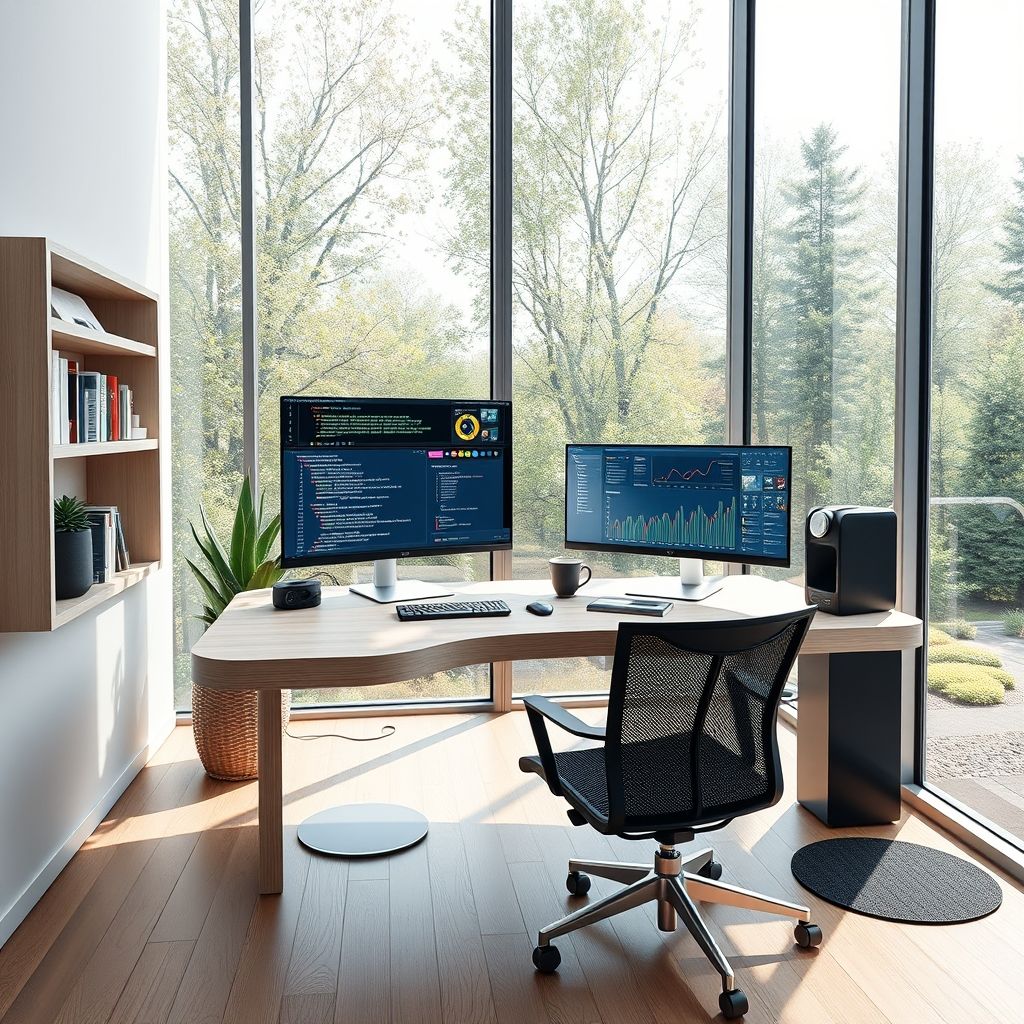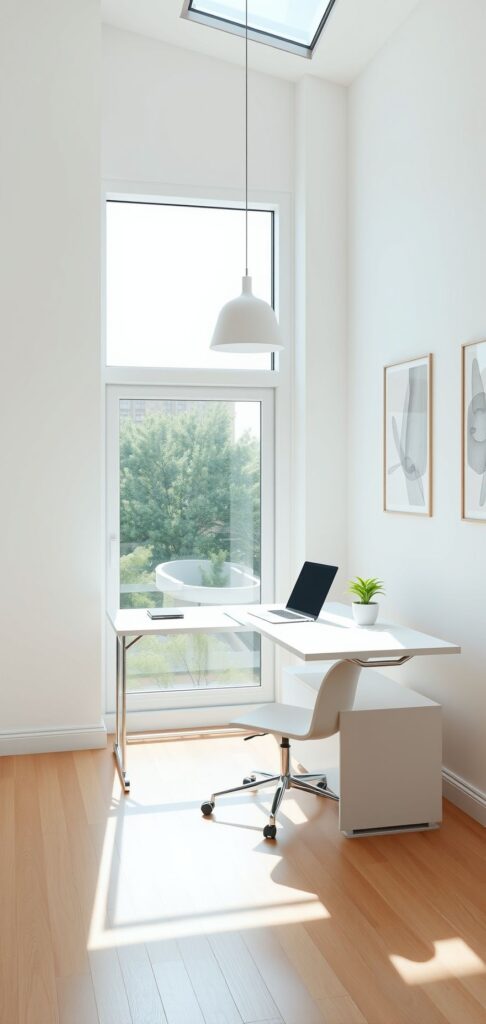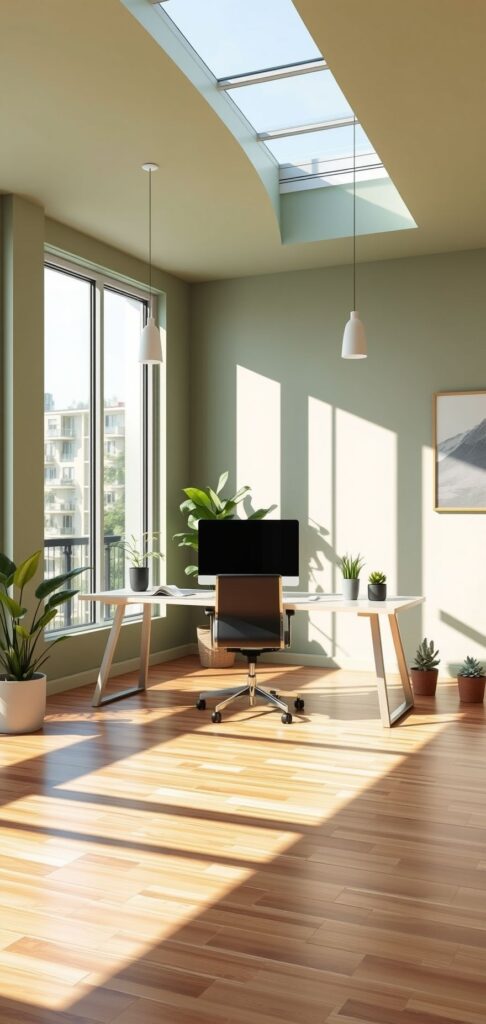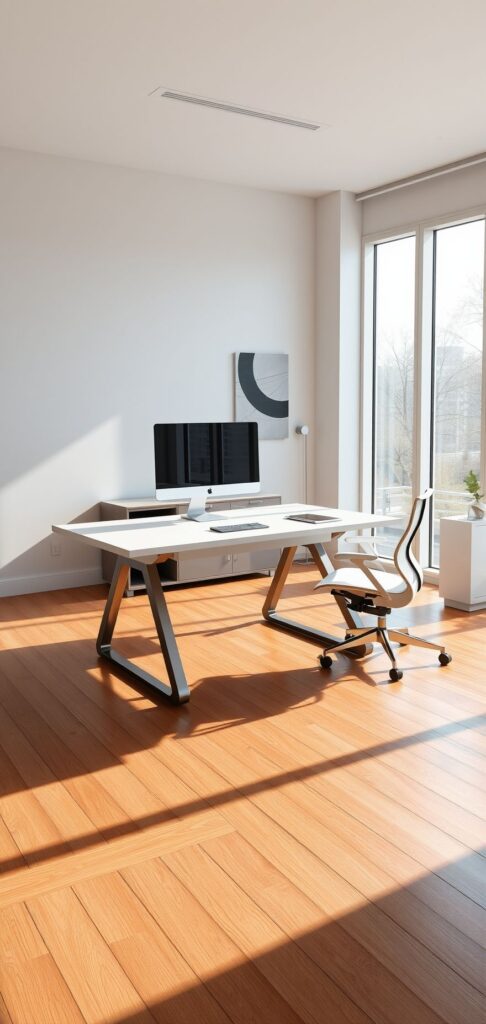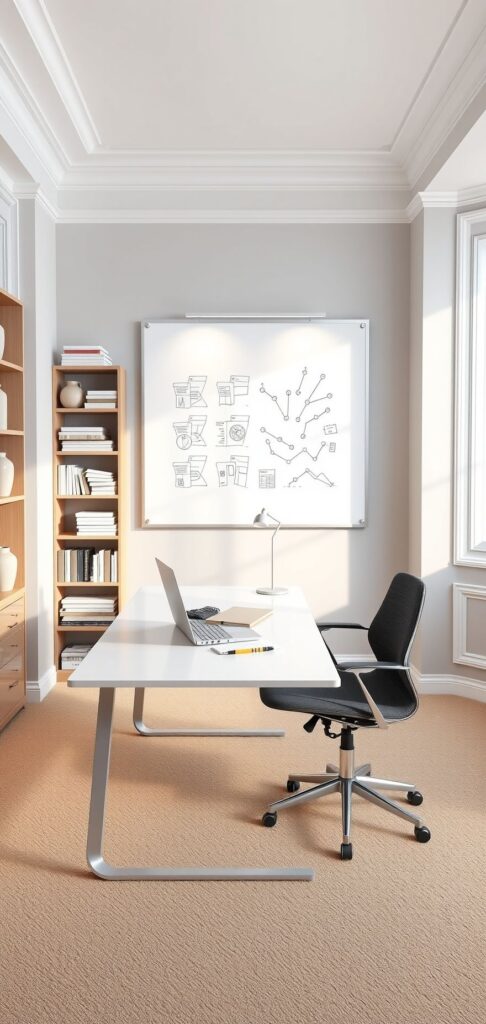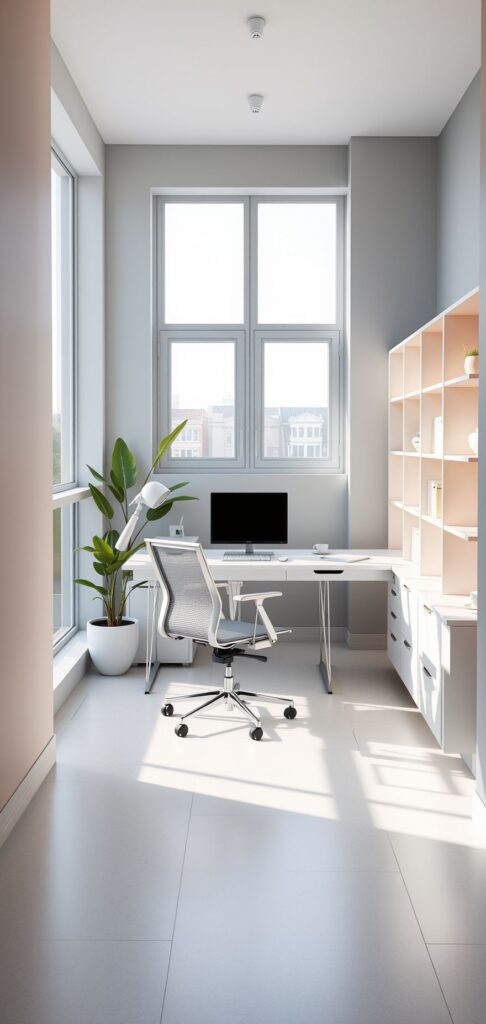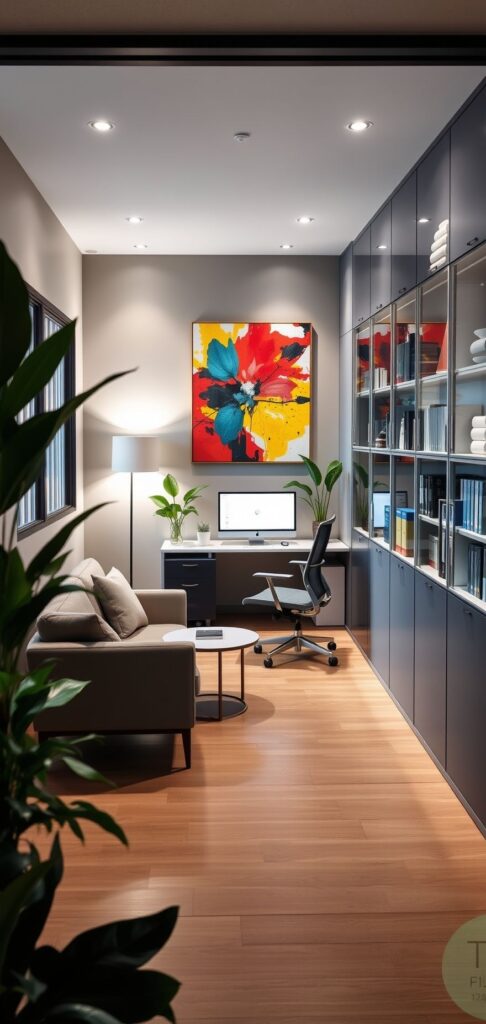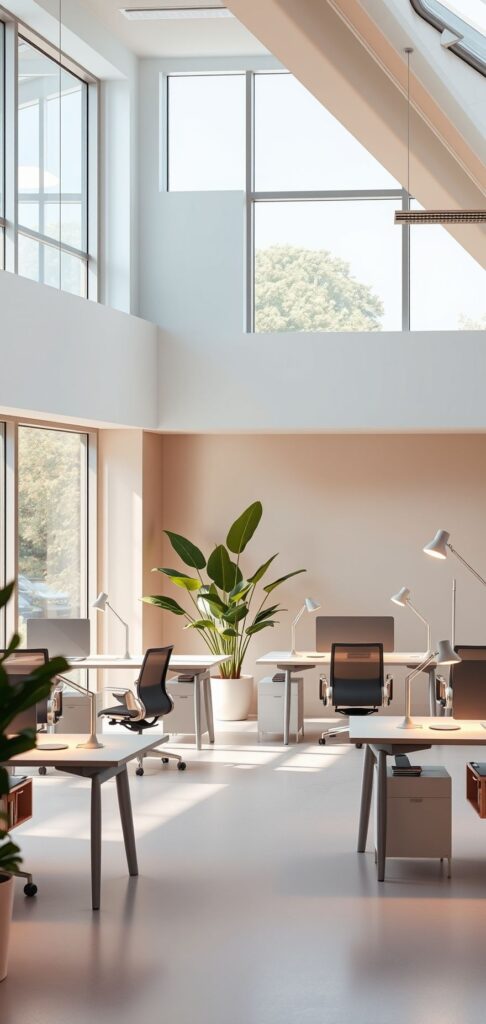Key Takeaways
- Embrace minimalist office design for a clutter-free environment: Simplify your space with clean lines, essential furniture, and a focus on functionality to reduce distractions and enhance focus.
- Incorporate biophilic design elements to boost well-being: Add plants, natural light, and nature-inspired colors to your office to improve air quality, reduce stress, and enhance your overall mood.
- Choose tech-integrated furniture for seamless connectivity: Opt for desks and seating that integrate charging ports, adjustable features, and ergonomic designs to keep your tech organized and accessible.
- Select a neutral color palette for a serene and professional look: Neutral tones like whites, grays, and beiges create a calming and professional atmosphere, perfect for maintaining focus and professionalism.
- Invest in multi-functional furniture to optimize space: Furniture that serves multiple purposes, such as storage ottomans and foldable desks, helps you maximize your office space, especially in smaller areas.
- Create distinct zones in your office for better organization: Designate specific areas for different tasks, such as a dedicated work zone, a relaxation corner, and a storage area, to keep your space organized and efficient.
- Use lighting to enhance the mood and productivity: Combine natural light with layered lighting options like overhead lights, task lights, and accent lights to create a well-lit and inviting workspace.
By incorporating these design tips, you can create a modern work office that not only looks great but also supports your productivity and well-being. Lets delve deeper into each of these elements to help you design a workspace that inspires and motivates you every day.
Imagine walking into an office that not only looks stunning but also makes you feel calm, focused, and ready to tackle the day. A well-designed work space can do wonders for your productivity and creativity, and the good news is, you don’t need a designers budget to achieve it.
Designing a modern work office that fosters productivity and creativity doesn’t have to be a daunting task. With the right inspiration and practical tips, you can transform your workspace into a haven of efficiency and inspiration. From embracing minimalist design to incorporating biophilic elements, and from tech-integrated furniture to creating distinct zones, these strategies will help you create a workspace that motivates and supports your daily tasks. Lets dive into each of these elements to help you design a modern office that inspires and motivates you every day.
Embrace Minimalist Office Design for a Clutter-Free Environment
Simplifying Your Space with Clean Lines and Essential Furniture
Minimalist office design is all about creating a clutter-free, organized space that promotes focus and productivity. This style emphasizes clean lines, simple forms, and essential furniture, creating a serene and efficient work environment. By reducing visual distractions and maintaining a tidy workspace, you can enhance your ability to concentrate and stay on task.
Benefits of a Clutter-Free Workspace
A clutter-free workspace reduces stress, improves mental clarity, and enhances focus. It allows you to work more efficiently by eliminating distractions and creating a sense of calm. When your environment is organized, you can find what you need quickly, which can significantly boost your productivity.
Tips for Decluttering and Maintaining a Minimalist Office
Start by removing unnecessary items and keeping only what you need. Use storage solutions such as drawers, shelves, and baskets to keep essential items organized and out of sight. Regularly reassess your space to ensure it remains clutter-free. Consider implementing a “one in, one out” rule, where you remove an item for every new one you add. This practice helps maintain a minimalist environment and prevents clutter from accumulating.
Incorporate Biophilic Design Elements to Boost Well-Being
Adding Plants, Natural Light, and Nature-Inspired Colors
Biophilic design integrates elements of nature into the built environment to enhance well-being and productivity. This can include plants, natural light, and nature-inspired colors, which have been shown to reduce stress, improve air quality, and enhance mood. By incorporating these elements, you can create a more inviting and healthy workspace.
How Plants Improve Air Quality and Reduce Stress
Adding plants to your office can significantly improve air quality by filtering out pollutants and increasing oxygen levels. They also have a calming effect, reducing stress and promoting relaxation. Plants like snake plants, peace lilies, and spider plants are excellent choices for office spaces as they are low-maintenance and effective air purifiers.
Importance of Natural Light and Nature-Inspired Colors
Natural light can boost mood and energy levels, while nature-inspired colors such as greens, blues, and earth tones create a calming and inviting atmosphere. If possible, position your desk near a window to maximize natural light exposure. If natural light is limited, consider using full-spectrum light bulbs that mimic natural sunlight. For color, incorporate nature-inspired hues through wall paint, decorative items, and office accessories.
Choose Tech-Integrated Furniture for Seamless Connectivity
Desks and Seating That Support Your Technology
Tech-integrated furniture is designed to support modern technology and enhance connectivity. Look for features such as built-in USB ports, wireless charging stations, and cable management systems. These features can help keep your workspace organized and functional, ensuring that you have easy access to the technology you need.
Benefits of Adjustable and Ergonomic Designs
Adjustable and ergonomic furniture can improve comfort and reduce the risk of strain and injury. It also allows you to customize your workspace to fit your specific needs. Adjustable desks, for example, can be raised or lowered to accommodate both sitting and standing positions, promoting better posture and reducing the risk of back pain.
Examples of Tech-Friendly Office Furniture
Some popular options include smart standing desks, ergonomic chairs with integrated tech features, and modular workstations that can be easily reconfigured. Smart standing desks often come with built-in USB ports and wireless charging stations, making it easy to keep your devices charged and connected. Ergonomic chairs with adjustable lumbar support and headrests can provide the support you need for long hours of work.
Select a Neutral Color Palette for a Serene and Professional Look
Creating a Calming and Professional Atmosphere
Neutral colors such as white, gray, and beige create a calm and professional atmosphere, making them ideal for office spaces. They provide a neutral backdrop that allows other design elements to stand out, creating a balanced and harmonious environment.
Popular Neutral Color Options for Office Spaces
Some popular neutral color options include shades of white, light gray, and soft beige. These colors can be combined to create a cohesive and inviting look. For example, a light gray wall can be paired with white furniture and beige accents to create a modern and professional space.
Tips for Choosing and Implementing a Neutral Color Palette
Start by selecting a base color for your walls and large furniture pieces. Use accent colors to add interest and personality to your space. Consider using texture and pattern to add depth to your neutral color scheme. For example, a textured rug or patterned curtains can add visual interest without overwhelming the space.
Invest in Multi-Functional Furniture to Optimize Space
Furniture That Serves Multiple Purposes
Multi-functional furniture is ideal for small offices as it allows you to maximize space and functionality. It can serve multiple purposes, reducing the need for additional furniture and creating a more efficient workspace. By choosing versatile pieces, you can create a functional and organized environment that meets your needs.
Examples of Multi-Functional Office Furniture
Some examples include ottomans with storage, sofa beds, and foldable tables. These pieces can be used for a variety of tasks, from working to relaxing. An ottoman with storage can double as a coffee table and a place to store office supplies, while a sofa bed can provide a comfortable seating area and a place to rest.
How to Maximize Space with Versatile Furniture Pieces
Consider the specific needs of your space and choose furniture that can be easily reconfigured or stored away when not in use. Use vertical space for storage and choose furniture with multiple functions. For example, a wall-mounted desk can be folded up when not in use, freeing up floor space. A bookshelf with built-in drawers can provide both storage and display space.
Create Distinct Zones in Your Office for Better Organization
Designating Specific Areas for Different Tasks
Creating distinct zones in your office can help you stay organized and focused. Each zone can be designed to support a specific task, such as work, relaxation, and storage. By clearly defining these areas, you can create a more functional and efficient workspace.
Tips for Designing a Dedicated Work Zone, Relaxation Corner, and Storage Area
Start by identifying the specific tasks you need to perform in your office. Use furniture and dividers to create separate areas for each task. For example, a desk and chair for your work zone, a comfortable chair or sofa for your relaxation corner, and shelves or drawers for your storage area. Use rugs or different flooring materials to visually separate the zones and create a cohesive look.
Examples of Well-Organized Office Spaces
Look for inspiration in well-organized office spaces that incorporate distinct zones. These can provide ideas for how to arrange your furniture and storage solutions to create a functional and organized workspace. For instance, a small home office might have a desk area with a standing desk and ergonomic chair, a relaxation corner with a comfortable armchair and a reading lamp, and a storage area with built-in shelves and cabinets.
Use Lighting to Enhance the Mood and Productivity
Combining Natural and Layered Lighting
Good lighting is essential for a functional and comfortable office space. It can enhance mood, reduce eye strain, and improve productivity. By combining natural and layered lighting, you can create a well-lit and inviting environment that supports your work and well-being.
Benefits of Natural Light and Layered Lighting Options
Natural light is the best source of lighting for your office, as it can boost mood and energy levels. Layered lighting, which combines overhead, task, and accent lights, can create a well-lit and inviting environment. Overhead lights provide general illumination, task lights focus on specific areas like your desk, and accent lights highlight design elements or create a warm ambiance.
Tips for Combining Overhead, Task, and Accent Lights
Use a combination of overhead lights for general illumination, task lights for focused work, and accent lights to highlight specific areas or design elements. This can create a balanced and functional lighting scheme. For overhead lighting, consider using recessed lights or pendant lamps. For task lighting, desk lamps or under-cabinet lights can provide the necessary illumination for your work area. Accent lights can be used to highlight artwork, plants, or other decorative elements, adding depth and interest to your space.
Minimalist office design, characterized by clean lines, essential furniture, and a clutter-free environment, is not just a trend but a powerful strategy to boost productivity and well-being. By reducing visual distractions and maintaining an organized workspace, you can enhance your focus and reduce stress, leading to more efficient and effective work.
Incorporating biophilic design elements, such as plants, natural light, and nature-inspired colors, further enhances this environment by improving air quality, reducing stress, and boosting mood. Tech-integrated furniture with features like built-in USB ports and ergonomic designs ensures seamless connectivity and comfort, while a neutral color palette creates a serene and professional atmosphere.
Investing in multi-functional furniture and creating distinct zones within your office maximizes space and functionality, making your workspace both practical and pleasant. Finally, combining natural and layered lighting can significantly enhance the mood and productivity of your office. By implementing these design principles, you can create an office that not only looks great but also supports your well-being and professional goals.
Consider these strategies as you design your office space, and remember that a well-organized and aesthetically pleasing environment can make a world of difference in your daily work life.

